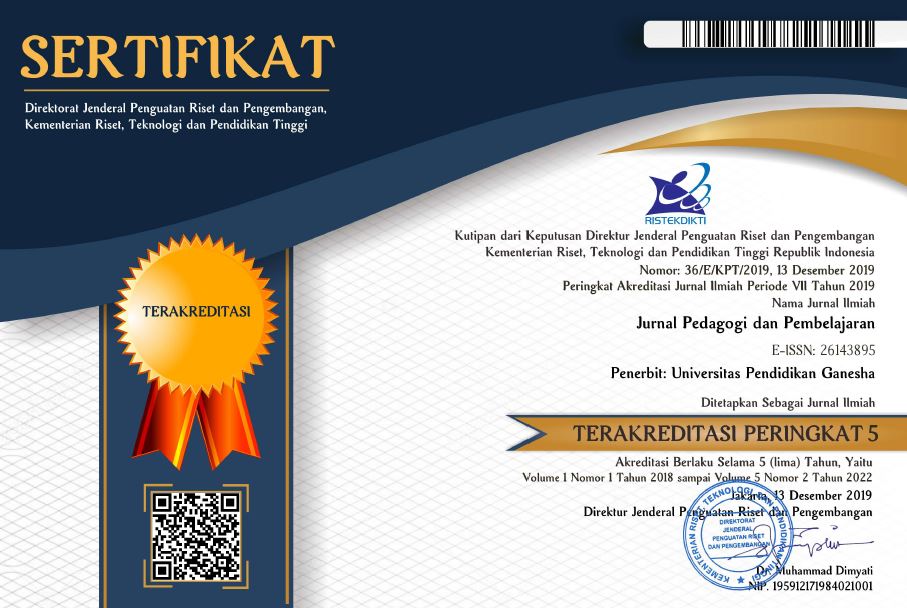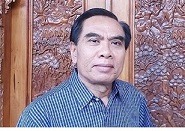Desain dan Uji Coba Penggunaan OpticalGamification (OG) Model Serial untuk Meningkatkan Keterampilan Berpikir Kritis Mahasiswa
DOI:
https://doi.org/10.23887/jp2.v3i3.29120Abstract
Penelitian ini bertujuan untuk merancang dan menguji coba aplikasi gamifikasi model serial pada perkuliahan gelombang dan optik khususnya pada topik interferensi dan difraksi. Metode penelitian yang digunakan adalah metode kuasi eksperimen dengan desain time series. Subyek penelitian ini melibatkan 20 mahasiswa fisika (L = 6, P = 14, rerata umur 19,5 tahun) yang mengikuti perkuliahan gelombang dan optik pada salah satu universitas di kota Bandung. Data keterampilan berpikir kritis mahasiswa dikumpulkan melalui teknik tes dengan instrumen berupa 32 soal pilihan ganda dan 4 soal pilihan ganda beralasan. Produk penelitian ini dinamai aplikasi OpticalGamification (OG) model serial. Hasil analisis data menunjukkan bahwa keterampilan berpikir kritis mahasiswa mengalami peningkatan pada setiap serinya.
References
Abramovich, S., Schunn, C., & Higashi, R. M. (2013). Are badges useful in education?: It depends upon the type of badge and expertise of learner. Educational Technology Research and Development, 61(2), 217–232.
Alifiyanti, I. F., & Ishafit. (2018). Penerapan model pembelajaran inkuiri terbimbing berbantuan PhET Simulation untuk meningkatkan kemampuan berpikir kritis siswa pada pokok bahasan teori kinetik gas di MAN 3 Ngawi. Prosiding Seminar Nasional Quantum, 392–400.
Ausubel, D. P. (1968). Educational Psychology. A Cognitive View. Holt, Rinehart, and Winston.
Barata, G., Gama, S., Jorge, J., & Gonçalves, D. (2013). Improving participation and learning with gamification. ACM International Conference Proceeding Series, 10–17. https://doi.org/10.1145/2583008.2583010
Bartel, A., & Hagel, G. (2014). Engaging students with a mobile game-based learning system in university education. International Journal of Interactive Mobile Technologies, 8(4), 56–60. https://doi.org/10.3991/ijim.v8i4.3991
Binkley, M., Erstad, O., Herman, J., Raizen, S., Ripley, M., Miller-Ricci, M., & Rumble, M. (2012). Assessment and teaching of 21st century skills. Springer Science+Business Media, 17–66. https://doi.org/10.1007/978-94-007-2324-5_2
Burkey, D. D., Anastasio, D. D., & Suresh, A. (2013). Improving student attitudes toward the capstone laboratory course using gamification. ASEE Annual Conference and Exposition, Conference Proceedings. https://doi.org/10.18260/1-2--19732
Dahar, R. W. (2011). Teori-Teori Belajar dan Pembelajaran. Erlangga.
Deterding, S., Antin, J., Paharia, R., & Lawley, E. (2012). Gamification: Designing for motivation. Interactions, 19(4), 14–17. https://doi.org/10.1145/2212877.2212883
Deterding, S., Dixon, D., Khaled, R., & Nacke, L. (2011). From game design elements to gamefulness. Proceedings of the 15th International Academic MindTrek Conference on Envisioning Future Media Environments - MindTrek ’11, 9. https://doi.org/10.1145/2181037.2181040
Ennis, R. H. (1985). A Logical Basis for Measuring Critical Thinking Skills. Educational Leadership. Oct85, 43(2), 44–48. https://doi.org/10.3102/0034654310376953
Flores, E. G. R., Montoya, M. S. R., & Mena, J. (2016). Challenge-based gamification and its impact in teaching mathematical modeling. ACM International Conference Proceeding Series, 02-04-Nove, 771–776. https://doi.org/10.1145/3012430.3012605
Gleason, N. W. (2018). Higher Education in the Era of the Fourth Industrial Revolution. https://doi.org/10.1007/978-981-13-0194-0
Gordon, N., Brayshaw, M., & Grey, S. (2013). Maximising gain for minimal pain: Utilising natural game mechanics. Innovation in Teaching and Learning in Information and Computer Sciences, 12(1), 27–38. https://doi.org/https://doi.org/10.11120/ital.2013.00004
Hake, R. R. (1998). Interactive-engagement versus traditional methods: A six-thousand-student survey of mechanics test data for introductory physics courses. American Journal of Physics, 66(1), 64–74. https://doi.org/10.1119/1.18809
Herayanti, L., & Habibi, H. (2017). Model Pembelajaran Berbasis Masalah Berbantuan Simulasi Komputer untuk Meningkatkan Keterampilan Berpikir Kritis Calon Guru Fisika. Jurnal Pendidikan Fisika Dan Teknologi, 1(1), 61. https://doi.org/10.29303/jpft.v1i1.236
Hew, K. F., Huang, B., Chu, K. W. S., & Chiu, D. K. W. (2016). Engaging Asian students through game mechanics: Findings from two experiment studies. Computers and Education, 92–93, 221–236. https://doi.org/10.1016/j.compedu.2015.10.010
Husein, S., Herayanti, L., & Gunawan, G. (2017). Pengaruh Penggunaan Multimedia Interaktif Terhadap Penguasaan Konsep dan Keterampilan Berpikir Kritis Siswa pada Materi Suhu dan Kalor. Jurnal Pendidikan Fisika Dan Teknologi, 1(3), 221. https://doi.org/10.29303/jpft.v1i3.262
Khalil, M., Ebner, M., & Admiraal, W. (2017). How can gamification improve MOOC student engagement? Proceedings of the 11th European Conference on Games Based Learning, ECGBL 2017, 819–828.
Kurniawan, D. T., Sanusi, N. M., & Kharimah, N. I. (2017). Pembelajaran Konsep Mekanika Fluida Statis Berbantuan Praktikum Virtual dalam Mengembangkan Keterampilan Berpikir Kritis Mahasiswa Calon Guru Matematika. 07(2), 110–118. https://doi.org/10.1006/jcat.1999.2588
Kyewski, E., & Krämer, N. C. (2018). To gamify or not to gamify? An experimental field study of the influence of badges on motivation, activity, and performance in an online learning course. Computers and Education, 118(November 2017), 25–37. https://doi.org/10.1016/j.compedu.2017.11.006
Mekler, E. D., Brühlmann, F., Tuch, A. N., & Opwis, K. (2017). Towards understanding the effects of individual gamification elements on intrinsic motivation and performance. Computers in Human Behavior, 71, 525–534. https://doi.org/10.1016/j.chb.2015.08.048
Mulyana, A., Hindersah, H., & Prihatmanto, A. S. (2016). Gamification design of traffic data collection through social reporting. Proceedings of the 2015 4th International Conference on Interactive Digital Media, ICIDM 2015. https://doi.org/10.1109/IDM.2015.7516315
Munandar, H., Sutrio, & Taufik, M. (2018). Pengaruh Model Pembelajaran Berbasis Masalah Berbantuan Media Animasi terhadap Kemampuan Berpikir Kritis dan Hasil Belajar Fisika Siswa SMAN 5 Mataram Tahun Ajaran 2016/2017. Jurnal Pendidikan Fisika Dan Teknologi, 4(1), 111–120.
Novak, J. D. (1977). A theory of education. Cornell University Press.
O’Donovan, S., Gain, J., & Marais, P. (2013). A case study in the gamification of a university-level games development course. ACM International Conference Proceeding Series, 242–251. https://doi.org/10.1145/2513456.2513469
Pierce, C. E., Gassman, S. L., & Huffman, J. T. (2013). Environments for fostering effective critical thinking in geotechnical engineering education (Geo-EFFECTs). European Journal of Engineering Education, 38(3), 281–299. https://doi.org/10.1080/03043797.2013.800021
Pirker, J., Riffnaller-Schiefer, M., & Gütl, C. (2014). Motivational active learning - Engaging university students in computer science education. ITICSE 2014 - Proceedings of the 2014 Innovation and Technology in Computer Science Education Conference, 297–302. https://doi.org/10.1145/2591708.2591750
Poondej, C., & Lerdpornkulrat, T. (2016). The development of gamified learning activities to increase student engagement in learning. Australian Educational Computing, 31(2).
Pradina, L. P., & Suyatna, A. (2018). Atom Core Interactive Electronic Book to Develop Self Efficacy and Critical Thinking Skills. Turkish Online Journal of Educational Technology - TOJET, 17(1), 17–23. http://ezproxy.lib.uconn.edu/login?url=https://search.ebscohost.com/login.aspx?direct=true&db=eric&AN=EJ1165751&site=ehost-live
Prensky, M. (2001). Fun , Play and Games : What Makes Games Engaging. Digital Game-Based Learning, 5(1), 1–31. http://www.autzones.com/din6000/textes/semaine13/Prensky(2001).pdf
Presseisen, B. Z. (1991). Thinking Skills: Meanings and Models Revisited. In Arthur L. Costa (Ed.), Developing Minds: A Resource Book for Teaching Thinking. Revised Edition, Volume 1 (Revised Ed, pp. 56–62). Association for Supervision and Curriculum Development. https://files.eric.ed.gov/fulltext/ED332166.pdf
Putra, P. D. A., & Sudarti. (2015a). Pengembangan Sistem E-Learning untuk Meningkatkan Keterampilan Berpikir Kritis Mahasiswa Pendidikan Fisika. Jurnal Fisika Indonesia, 19(55), 45–48. www.wisiq.com.
Putra, P. D. A., & Sudarti. (2015b). Real life video evaluation with e-learning system to improve critical thinking skills student. Jurnal Kependidikan, 45(1), 76–89.
Rose, J. A., O’Meara, J. M., Gerhardt, T. C., & Williams, M. (2016). Gamification: Using elements of video games to improve engagement in an undergraduate physics class. Physics Education, 51(5), 1–7. https://doi.org/10.1088/0031-9120/51/5/055007
Saprudin, S., Liliasari, L., & Prihatmanto, A. S. (2017). Pre-Service Physics Teachers’ Concept Mastery and the Challenges of Game Development on Physics Learning. Journal of Physics: Conference Series, 895(1). https://doi.org/10.1088/1742-6596/895/1/012109
Saprudin, S., Liliasari, S., Prihatmanto, A. S., & Setiawan, A. (2019a). Profile of pre-service physics teachers’ creative thinking skills on wave and optics course. Journal of Physics: Conference Series, 1157(3). https://doi.org/10.1088/1742-6596/1157/3/032030
Saprudin, S., Liliasari, S., Prihatmanto, A. S., & Setiawan, A. (2019b). Pre-service physics teachers’ thinking styles and its relationship with critical thinking skills on learning interference and diffraction. Journal of Physics: Conference Series, 1157(3). https://doi.org/10.1088/1742-6596/1157/3/032029
Saprudin, S., Liliasari, S., Prihatmanto, A. S., Setiawan, A., Viridi, S., Safitri, H., Yulina, I. K., & Rochman, C. (2020b). Gamified experimental data on physics experiment to measuring the acceleration due to gravity. Journal of Physics: Conference Series, 1567(3). https://doi.org/10.1088/1742-6596/1567/3/032079
Saprudin, S. (2018). Analisis Kesiapan dan Strategi Monitoring Evaluasi Program Pengembangan Perkuliahan Gelombang dan Optik Berbasis Game. JIPFRI (Jurnal Inovasi Pendidikan Fisika Dan Riset Ilmiah), 2(1), 28–37. https://doi.org/https://doi.org/10.30599/jipfri.v2i1.207
Saprudin, S, Liliasari, L., Prihatmanto, A. S., & Setiawan, A. (2019). The Potential of Gamification in Developing Pre-Service Physics Teachers’ Critical and Creative Thinking Skills. Omega: Jurnal Fisika Dan Pendidikan Fisika, 5(1), 167–171. https://doi.org/10.31758/OMEGAJPHYSPHYSEDUC.V5I1.7
Saprudin, Saprudin, Liliasari, L., Setiawan, A., & Prihatmanto, A. S. (2019). The effectiveness of using digital game towards students’ academic achievement in small and large classes: A comparative research. International Journal of Learning, Teaching and Educational Research, 18(12). https://doi.org/10.26803/ijlter.18.12.12
Saprudin, Saprudin, Liliasari, L., Setiawan, A., & Prihatmanto, A. S. (2020). Optical Gamification (OG); Serial Versus Random Model to Improve Pre-Service Physics Teachers’ Concept Mastery. International Journal of Emerging Technologies in Learning (IJET), 15(09). https://doi.org/10.3991/ijet.v15i09.11779
Schunk, D. H. (2012). Learning Theories an Educational Perspective, Sixth Edition (Teori-teori Pembelajaran: Perspektif Pendidikan). Pustaka Pelajar: Yogyakarta.
Yüksel, G., & Alcı, B. (2012). Self-efficacy and critical thinking dispositions as predictors of success in school practicum. International Online Journal of Educational Sciences, 4(1), 81–90.
Zhou, Q., Huang, Q., & Tian, H. (2013). Developing Students’ Critical Thinking Skills by Task-Based Learning in Chemistry Experiment Teaching. Creative Education, 04(12), 40–45. https://doi.org/10.4236/ce.2013.412a1006
Downloads
Published
How to Cite
Issue
Section
License
Authors who publish with Jurnal Pedagogi dan Pembelajaran agree to the following terms:- Authors retain copyright and grant the journal the right of first publication with the work simultaneously licensed under a Creative Commons Attribution License (CC BY-SA 4.0) that allows others to share the work with an acknowledgment of the work's authorship and initial publication in this journal
- Authors are able to enter into separate, additional contractual arrangements for the non-exclusive distribution of the journal's published version of the work (e.g., post it to an institutional repository or publish it in a book), with an acknowledgment of its initial publication in this journal.
- Authors are permitted and encouraged to post their work online (e.g., in institutional repositories or on their website) prior to and during the submission process, as it can lead to productive exchanges, as well as earlier and greater citation of published work. (See The Effect of Open Access)













